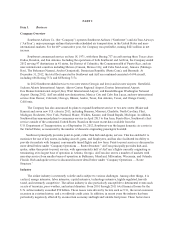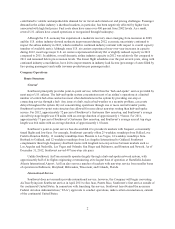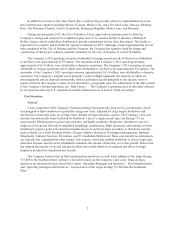Southwest Airlines 2012 Annual Report Download - page 19
Download and view the complete annual report
Please find page 19 of the 2012 Southwest Airlines annual report below. You can navigate through the pages in the report by either clicking on the pages listed below, or by using the keyword search tool below to find specific information within the annual report.Once the Altea implementation is complete, the Company intends to begin a multi-year project to replace
Southwest’s existing domestic reservation system with a comprehensive system that would incorporate the new
Altea solution. The combined system would provide the ability to serve both domestic and international
destinations and allow for other Customer Service, revenue management, and schedule production capabilities.
The Amadeus contract provides the option for Southwest to migrate its domestic business to a combined
Amadeus solution if it so chooses.
Other Strategic Initiatives
Network Optimization and Revenue Management
During 2012, the Company continued to use profitability management tools to aggressively manage
capacity and route expansion through optimization of its flight schedule to better match demand in certain
markets. These efforts contributed to higher yields, strong load factors, and improved revenues during 2012. The
Company also set the stage for longterm growth by further coordinating the Southwest and AirTran flight
schedules and making significant progress towards implementing connecting capabilities between the Southwest
and AirTran reservations systems. These enhancements will allow Customers to book flights on either carrier
through a single source and to book connecting itineraries between the two carriers. Full deployment of such
connecting capabilities is expected to occur in early 2013 and is expected to enable significant network
optimization.
The Company’s network is continually changing through the addition of new markets, the adjustment of
frequencies in existing markets, and the exiting of certain markets. In response to high fuel prices, the Company
has discontinued service in 15 AirTran destinations, eliminated certain routes that proved unsustainable, and
redeployed aircraft to other markets. Passenger demand in the Company’s shorthaul markets, in particular, has
been negatively affected by higher fares associated with high fuel prices.
As part of the Company’s network optimization efforts, during 2013 the Company also intends to improve
its operational network efficiency by tightening its scheduled aircraft flying hours per day and turn times. These
changes are designed to better utilize available aircraft time during the peak flying hours of each day and are
expected to lead to increased revenue production and less aircraft ground time.
The Company expects the optimization and alignment of the Southwest and AirTran schedules and
networks to be a multi-year undertaking, but believes these efforts can yield significant synergies and financial
benefits. The Company intends to continue its network optimization efforts with the goal of profitably expanding
the depth and reach of its overall network.
During the first half of 2013, the Company also plans to introduce the first phase of a new revenue
management system with added revenue management capabilities designed to drive further revenue growth. The
new revenue management system will be an origin and destination based revenue management system, which
will replace a segment based system. The new system is designed to allow for a more precise management of
Customer demand and inventory and to allow the Company to manage demand in terms of where the Company’s
Customers want to fly, regardless of how they route or connect. The Company expects to implement additional
revenue management tools over the next several years.
Cost Containment
Over the last several years, the Company has undertaken a number of cost-containment projects for the
purpose of preserving Southwest’s low-cost advantage and low-fare brand. These have included the network
optimization and fleet modernization strategies discussed above. In addition, these have included various fuel
conservation and carbon emission reduction initiatives such as the following:
• installation of blended winglets, which reduce drag and increase fuel efficiency, on all Boeing
737-700 and 737-800 aircraft in Southwest’s fleet and on a majority of Southwest’s 737-300 aircraft;
• periodic engine washes;
11
























